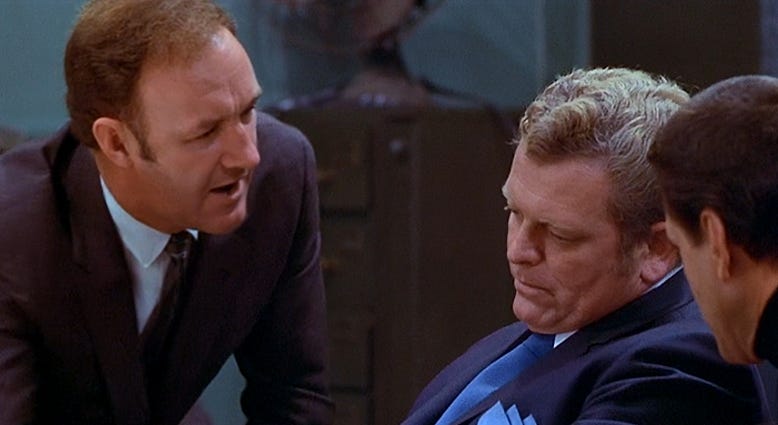Here’s a post based on this week’s episode of Fifteen-Minute Film Fanatics, a podcast that often breaks the promise of its title but never wastes the listener’s time. The post and the podcast complement each other. We take requests, so leave a comment below if there’s a film you’d like us to cover. We’ve done over three hundred episodes that you can find on Spotify, Apple, or wherever you get your podcasts. Please subscribe and listen wherever you get your podcasts and consider leaving a review on your platform of choice. Thanks.
The buzz surrounding a biopic is usually measured by the degree to which the actor meets the collective imagined “reality” of its subject: Gary Oldman as Churchill, Margot Robbie as Tonya Harding, and Timothée Chalamet as Bob Dylan were all praised for the mimicry at the heart of their performances. Sometimes (Lincoln) the mimicry is better than anything else on the screen; sometimes (Man in the Moon) the mimicry isn’t perfect yet this doesn’t detract from the overall quality; sometimes (Raging Bull) the perfect mimicry is matched by an equally perfect film that does so much more than tell one man’s story. We initially judge the success of the film on the strength of the imitation, but if the film isn’t any good, the imitation is just an expensive version of what Steve Coogan and Rob Brydon do in The Trip when they try to out-Michael-Caine each other.
The great mimics also sear themselves into our imaginations. Hollywood sometimes convinces us to see in our mind’s eye, for the rest of our lives, the actor as the real person. Who can now read about George S. Patton and not visualize George C. Scott in whatever the author is describing? Pick up Patton: A Genius for War and try to read it without picturing Scott. You can’t. What reader of David McCullough’s John Adams can avoid Paul Giamatti as he moves through the book? If those guys earned royalties for each time someone thought of them during a history lecture, they’d be as rich as Croesus (who, as far as I know, has not been portrayed on screen).
When we hear the word “biopic,” we think of a famous person playing another famous person (Ali) or one that the filmmaker thinks should be better known (Hotel Rwanda). But we sometimes forget that there is a whole wing of the biopics warehouse in which actors play real people of whom we have very little or no notions of their subjects’ appearance, talk, gait, or expressions. Nobody watches Ford vs. Ferrari and praises the way in which Christian Bale imitates Ken Miles. (I know, I know—there are people with extensive knowledge of racing who do appreciate it, but the layperson takes it on faith that the real Ken Miles was something close to Bale’s performance.) Robert Downey Jr. was praised for his portrayal of Lewis Strauss in Oppenheimer because of his intensity, not because he captured anything about the actual man’s physical reality. Everybody admires Gene Hackman’s portrayal of the real-life Eddie Egan in The French Connection, but none of that admiration has anything to do with Hackman’s ability to mimic the real man. Even when we see the real Eddie Egan make his cameo as Hackman’s boss, we don’t begin comparing his looks to the man portraying him. We’re too involved in the film. The thought of comparing them never enters our minds.
Biopics of figures from further back in time work the same way, trading mimicry for authenticity. When we watch A Man for All Seasons, we don’t wonder about the degree to which Paul Schofield “acts like” Sir Thomas More. Granted, we wouldn’t be able to take seriously someone who didn’t give the “More vibe,” but we are far less concerned with mimicry than we are when we see actors portraying people whose speech and mannerisms have already been imitated by millions of fans. The actor playing More needs gravitas; the one playing Elvis needs something else.
Love and Mercy (2014) gets to have its biopic cake and eat it, too. The parts in which Paul Dano plays Brian Wilson working on Pet Sounds with a level of Kubrick-like intensity are exactly what we expect from the genre: the clothes, lighting, and haircuts are perfect and everybody looks enough like who they are portraying that the illusion of watching Wilson and Mike Love bickering about “the formula” is sustained. The indoor sandbox, the endless sessions in which Brian instructs the cellists that they need to “sound like propellers,” and Brian’s abusive father are all parts of the story we recognize from a lifetime of listening to people talk about the band. We almost check them off as we watch, just as millions of Bob Snobs did with the events in A Complete Unknown.
We also get the required biopic element of everyone in the subject’s orbit second-guessing his vision. When Brian plays a rough version of “God Only Knows” to his father, who says it sounds like a suicide note, the viewer is invited to feel superior to him who, having ears, hears not. One day there will be a musical biopic in which everyone who hears the subject’s music for the first time is as moved as we all were upon first hearing, but we’re not there yet and that wouldn’t make for any drama. We all know about Brian Wilson’s father the way we know about Colonel Tom Parker, we’ve all heard about the genesis of “Good Vibrations,” and we’ve all assumed (with reason) that LSD replaced the Pacific as a source of inspiration. When we see these elements dramatized as well as they are here, we nod along.
But the parts with John Cusack as the older Brian trying to break free from the grip of Dr. Landy have the effect of channel surfing and discovering the second kind of biopic in which mimicry is no longer a feature. Cusack looks vaguely like an older Brian Wilson, but the resemblance isn’t as strong as Paul Dano’s to the younger one—yet, as with the examples mentioned above, it doesn’t matter. Cusack suggests, through his performance, the kind of person the older Wilson was like and that’s what the viewer needs to make these parts of the film succeed. As with The French Connection, nobody cares about the mimicry because the character becomes more interesting than any weight gain or loss, makeup, or prosthetics. (The filmmakers of Better Man, the 2024 biopic of Robbie Williams, took this notion a mile further when when they substituted a CGI–generated chimpanzee for its subject.)
The two performances are skillfully arranged so that we don’t get a Pet Sounds half followed by a Dr. Landry half. Watching the two stories proceed as each is interrupted by the other is akin to watching The Godfather, Part II and thinking about the relationship (beyond blood) between past Vito and present Michael. We get to see how the sausage is made in terms of the music and the man and how the two things mentioned in the title finally free Brian from the cage in which he has allowed himself to be held. It’s a great biopic as well as a great movie.
Listen to the episode here or wherever you get your podcasts:






I don't know that I can watch John Cusack in anything music-related and not see Rob Gordon.
“One day there will be a musical biopic in which everyone who hears the subject’s music for the first time is as moved as we all were upon first hearing, but we’re not there yet and that wouldn’t make for any drama.”
I think that describes A Complete Unknown. Woody and Pete in the hospital, Joan and the talent guy at the club.